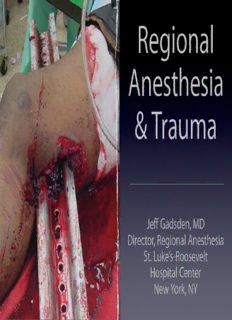
Jeff Gadsden, MD Director, Regional Anesthesia St. Luke's-Roosevelt Hospital Center New York, NY PDF
Preview Jeff Gadsden, MD Director, Regional Anesthesia St. Luke's-Roosevelt Hospital Center New York, NY
Regional Anesthesia & Trauma Jeff Gadsden, MD Director, Regional Anesthesia St. Luke’s-Roosevelt Hospital Center New York, NY Objectives • Outline the role of regional anesthesia in trauma care • Discuss acute compartment syndrome in relation to regional anesthesia and trauma • Cite specific examples where regional anesthesia can make a difference in injured patients Oligoanalgesia in trauma • Hemodynamic instability • Neurologic impairment • Fear of airway compromise • Higher injury severity score • Age-related changes in PK/PD • Delirium • Interference with assessments Mean time to analgesia: 126 min Those receiving femoral NB: 7% Emerg Med Australas 2010;22:3-8 Advantages • Site-specific, high quality analgesia • Reduction in opioid use & associated adverse effects • Decreased need for sedatives • Reduction in ER length of stay (vs. procedural sedation) • More efficient use of resources (e.g. less nursing for monitoring) • Inexpensive • Potential reduction in risk of CRPS & PTSD Choi J, et al. Curr Opinion Anaesth 2013 Barriers to RA? • Other priorities (ABCDs) • Lack of training • Perceived risk of neurologic or other complications (e.g. compartment syndrome) • “Already getting a GA” When should RA be used?
Description: